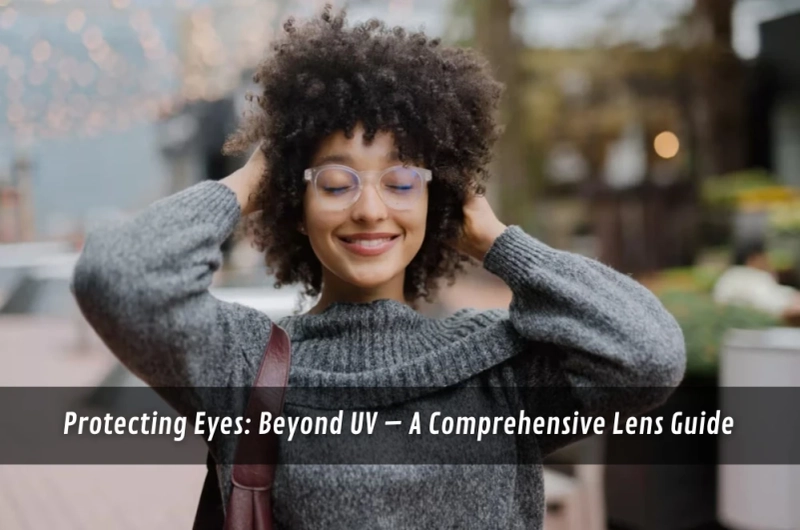When we talk about looking after our vision, sunglasses are usually the first thing people think about. Block the sun. Protect from UV. Job done — or so it seems. But after years of working, driving, and squinting at screens, I’ve realised there’s more to the story. Glare, tiny scratches, harsh lighting… they all chip away at comfort and clarity. It’s not just about shielding from the sun, comprehensive eye protection means choosing lenses and coatings that work together to handle everything from glare to scratches, keeping your vision clear in whatever setting you find yourself.
It’s not just a fancy term for expensive eyewear. It’s a mix of lens coatings, frame fit, and even small daily habits that keep your vision working for you. The right combination means you’re not battling reflections during a night drive or rubbing tired eyes after a day in front of a laptop. And honestly? It’s the difference between “good enough” vision and the kind you don’t even have to think about. Which, when you’re busy living life, is exactly how it should be.
Why UV protection is only the start
Australia’s bright conditions are perfect for beach days and morning walks, but they’re not so friendly to unprotected eyes. UV light can cause real harm over time, sure — but that’s only part of the problem.
Other everyday annoyances stack up:
- Glare bouncing off car windscreens and water
- Blue light from endless screen time
- Dust and smudges make lenses cloudy
- Scratches that quietly distort what you see
I once went an entire summer relying only on sunglasses, thinking they were enough. By the end of it, I noticed my regular prescription lenses were scratched, my night driving had become a chore, and my eyes were working harder than they should.
Understanding lens coatings that make a difference
Lens coatings aren’t just a gimmick your optometrist throws in to upsell. Each one has a very specific job, and once you’ve experienced them, it’s hard to go back.
Anti-reflective coating
This one’s a lifesaver at night. It cuts down on that blinding halo effect from headlights and streetlamps. I remember one particular drive home after skipping this coating — the glare felt like it was drilling into my skull. By the time I pulled into the driveway, I was more exhausted from squinting than from the actual drive.
Blue-light filtering
If you spend most of your day glued to a laptop or phone, this can help. It takes the edge off harsh screen glare and might even help you wind down at night.
Scratch resistance
Think of it as armour for your lenses. Not invincible, but definitely tougher against the odd knock or swipe with a shirt sleeve (which, let’s be honest, we all do).
Choosing combinations for your needs
You don’t have to settle on just one coating. Pairing them is often the smartest move. Anti-reflective plus blue-light filtering is a favourite combo for anyone who works indoors and drives at night. Outdoor lovers often go for UV protection plus scratch resistance — sometimes with a photochromic coating for extra convenience.
Your lifestyle should guide your choices. Someone cycling to work each day will have different needs than someone who spends most of their time indoors. And if you’re somewhere in between? Mixing coatings to cover both worlds makes sense.
Supporting your vision with healthy eye care practices
Even the best lenses can’t do it all. Protecting your sight for the long haul comes from pairing good eyewear with healthy eye care practices, the little habits that make a big difference over time.
A few I stick to:
- Adjusting screen brightness to match room light
- Setting up my desk so I’m not squinting against glare
- Taking a quick pause from close work every hour or so
I noticed that after making these changes, the gritty, tired feeling I used to get late in the day mostly disappeared. It’s a reminder that small, consistent actions work alongside your lenses, helping your eyes stay clearer and more comfortable as the hours roll on.
Making frame choices with tips for choosing reading glasses in mind
Frames matter more than we give them credit for. The wrong size or shape can undo the benefits of your coatings. Thinking about tips for choosing reading glasses can help, even if you’re buying prescription eyewear for everyday use. When I got my first pair of reading glasses, I made the rookie mistake of focusing only on how they looked in the shop mirror.
Now I check for:
- A snug but not pinching fit
- Lenses sitting at the right height for my eyes
- Lightweight materials for longer wear
- Arm length that keeps them stable without pressure
Once, I switched to a frame that was slightly too loose because I liked the style. Within weeks, I was adjusting them so often that the lenses were picking up tiny scratches from my fingertips. A better-fitting pair fixed both the comfort and the wear issues.

Maximising comfort with customised eyewear solutions
The best coatings can still underperform if your glasses aren’t positioned correctly — and that’s where customised eyewear solutions can make a real difference. Once I tried a truly customised fit, I realised how much difference a few millimetres can make. Lenses that sit too low or too far forward don’t deliver the same clarity, no matter how good the coating is.
For example, a friend who spends his weekends sailing had his lenses adjusted so they’d give maximum peripheral vision without glare bouncing in from the sides. The optician also tweaked the tilt so water reflections didn’t hit directly. These small adjustments made his time on the water far more comfortable — and meant he could keep wearing his glasses all day without that creeping ache behind the eyes.
Final thoughts
Lens coatings aren’t about overcomplicating your eyewear. They’re about removing the small irritations — the glare, the strain, the cloudy view — so you can just get on with your day. When you combine them with a good frame fit and consistent care, you get more than just protection; you get comfort and clarity that lasts.


